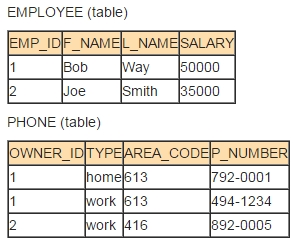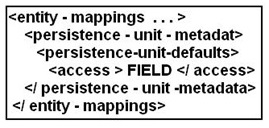Oracle 1z0-898 Exam Practice Questions (P. 2)
- Full Access (63 questions)
- One Year of Premium Access
- Access to one million comments
- Seamless ChatGPT Integration
- Ability to download PDF files
- Anki Flashcard files for revision
- No Captcha & No AdSense
- Advanced Exam Configuration
Question #6
A developer is creating an entity which is mapped to a table that has a primary key constraint defined on two character columns and would like to use mapping defaults as much as possible to simplify the code.
Which two mapping options can be chosen? (Choose two.)
Which two mapping options can be chosen? (Choose two.)
- AUse an @id property that constructs a private field as a concatenation of two columns.
- BUse a separate class to map those two columns and use an @idclass annotation to denote I primary key field or property in the entity.
- CUse a separate @Embeddable class to map those two columns and use an @EmbeddedId annotation to denote a single primary key field or property in the entity.
- DUse a separate @Embeddable class to map those two column and add two fields or properties the entity, each marked as @id, that correspond to the fields or properties in the embeddable class.
- EUse a separate class to map those two columns. Specify that class using @Idclass annotation on the entity class. Add two fields or properties to the entity,
Correct Answer:
CE
C: Annotation Type EmbeddedId -
Applied to a persistent field or property of an entity class or mapped superclass to denote a composite primary key that is an embeddable class. The embeddable class must be annotated as Embeddable.
E: Annotation Type IdClass -
Specifies a composite primary key class that is mapped to multiple fields or properties of the entity. The names of the fields or properties in the primary key class and the primary key fields or properties of the entity must correspond and their types must be the same.
Example:
@IdClass(com.acme.EmployeePK.class)
@Entity
public class Employee {
@Id String empName;
@Id Date birthDay;
...
}
Reference: javax.persistence, Annotation Type EmbeddedId
javax.persistence , Annotation Type IdClass
CE
C: Annotation Type EmbeddedId -
Applied to a persistent field or property of an entity class or mapped superclass to denote a composite primary key that is an embeddable class. The embeddable class must be annotated as Embeddable.
E: Annotation Type IdClass -
Specifies a composite primary key class that is mapped to multiple fields or properties of the entity. The names of the fields or properties in the primary key class and the primary key fields or properties of the entity must correspond and their types must be the same.
Example:
@IdClass(com.acme.EmployeePK.class)
@Entity
public class Employee {
@Id String empName;
@Id Date birthDay;
...
}
Reference: javax.persistence, Annotation Type EmbeddedId
javax.persistence , Annotation Type IdClass
send
light_mode
delete
Question #7
A developer wants to model the grades for a student as a Map<course, integer>. Assume that Student and Course are entitles, and that grades are modeled by integers.
Which of the following two statements are correct? (Choose two)
Which of the following two statements are correct? (Choose two)
- AThe developer can model the grades as an element collection in the Student entity.
- BThe developer can model the grades as a oneToMany relationship in the Student entity.
- CThe mapping for the key of the map can be specified by the @MapKeycolumn annotation.
- DThe mapping for the value of the map can be specified by the @Column annotation.
Correct Answer:
AD
A: JPA 2.0 defines an ElementCollection mapping. It is meant to handle several non-standard relationship mappings. An ElementCollection can be used to define a one-to-many relationship to an Embeddable object, or a Basic value (such as a collection of Strings). An ElementCollection can also be used in combination with a Map to define relationships where the key can be any type of object, and the value is an Embeddable object or a Basic value.
D:
Example of an ElementCollection relationship database:

Example of an ElementCollection relationship annotations
@Entity
public class Employee {
@Id
@Column(name="EMP_ID")
private long id;
...
@ElementCollection
@CollectionTable(
name="PHONE",
joinColumns=@JoinColumn(name="OWNER_ID")
)
private List<Phone> phones;
...
}
@Embeddable
public class Phone {
private String type;
private String areaCode;
@Column(name="P_NUMBER")
private String number;
...
}
Reference: Java Persistence/ElementCollection
AD
A: JPA 2.0 defines an ElementCollection mapping. It is meant to handle several non-standard relationship mappings. An ElementCollection can be used to define a one-to-many relationship to an Embeddable object, or a Basic value (such as a collection of Strings). An ElementCollection can also be used in combination with a Map to define relationships where the key can be any type of object, and the value is an Embeddable object or a Basic value.
D:
Example of an ElementCollection relationship database:

Example of an ElementCollection relationship annotations
@Entity
public class Employee {
@Id
@Column(name="EMP_ID")
private long id;
...
@ElementCollection
@CollectionTable(
name="PHONE",
joinColumns=@JoinColumn(name="OWNER_ID")
)
private List<Phone> phones;
...
}
@Embeddable
public class Phone {
private String type;
private String areaCode;
@Column(name="P_NUMBER")
private String number;
...
}
Reference: Java Persistence/ElementCollection
send
light_mode
delete
Question #8
Consider a persistence application with the following orm.xml:

What will be the effect of the above orm.xml?

What will be the effect of the above orm.xml?
- AThe access type for only those entities that have not explicitly specified @Access will be defaulted to field.
- BThe access type for all entities in the persistence unit will be changed to FIELD.
- CThe access type for all entities specified in this orm.xml will be changed to FIELD.
- DThe access type for only those entities defined in this orm.xml for which access is not specified will be defaulted to FIELD.
Correct Answer:
D
Set the default to FIELD-access.
Note: persistence-unit-defaults -
Rule: Full override -
Description: If a schema setting exists, then the eclipselink-orm.xml schema setting overrides the existing setting or creates a new schema setting.
D
Set the default to FIELD-access.
Note: persistence-unit-defaults -
Rule: Full override -
Description: If a schema setting exists, then the eclipselink-orm.xml schema setting overrides the existing setting or creates a new schema setting.
send
light_mode
delete
Question #9
A developer has created an application managed entity manager.
Which statement is correct?
Which statement is correct?
- AA new persistence context begins when the entity manager is created.
- BA new persistence context begins when a new JTA transaction begins.
- CA new persistence context begins when the entity manager is invoked in the context o\ transaction.
- DA new persistence context begins when the entity manager is invoked in the context of a resource-local transaction.
Correct Answer:
A
Application-Managed Entity Managers
With an application-managed entity manager the persistence context is not propagated to application components, and the lifecycle of EntityManager instances is managed by the application.
Application-managed entity managers are used when applications need to access a persistence context that is not propagated with the JTA transaction across
EntityManager instances in a particular persistence unit. In this case, each EntityManager creates a new, isolated persistence context. The EntityManager and its associated persistence context are created and destroyed explicitly by the application.
Reference: The Java EE 6 Tutorial, Managing Entities
http://docs.oracle.com/javaee/6/tutorial/doc/bnbqw.html#bnbra
A
Application-Managed Entity Managers
With an application-managed entity manager the persistence context is not propagated to application components, and the lifecycle of EntityManager instances is managed by the application.
Application-managed entity managers are used when applications need to access a persistence context that is not propagated with the JTA transaction across
EntityManager instances in a particular persistence unit. In this case, each EntityManager creates a new, isolated persistence context. The EntityManager and its associated persistence context are created and destroyed explicitly by the application.
Reference: The Java EE 6 Tutorial, Managing Entities
http://docs.oracle.com/javaee/6/tutorial/doc/bnbqw.html#bnbra
send
light_mode
delete
Question #10
Given:
@PersistenceContext EntityManager em;
public boolean test(Order o) {
boolean b = false;
o = em.merge(o);
em.remove(o);
o = em.merge(o);
b = em.contains(o);
return b;
}
Which statement is correct?
@PersistenceContext EntityManager em;
public boolean test(Order o) {
boolean b = false;
o = em.merge(o);
em.remove(o);
o = em.merge(o);
b = em.contains(o);
return b;
}
Which statement is correct?
- AThe method will return TRUE.
- BThe method will return FALSE.
- CThe method will throw an exception.
- DThe order instance will be removed from the database.
Correct Answer:
A
* Order
An object that defines an ordering over the query results.
* merge(T entity)
Merge the state of the given entity into the current persistence context
*
remove
(java.lang.Object entity)
Remove the entity instance.
* contains(java.lang.Object entity)
Check if the instance is a managed entity instance belonging to the current persistence context.
Note: An EntityManager instance is associated with a persistence context. A persistence context is a set of entity instances in which for any persistent entity identity there is a unique entity instance. Within the persistence context, the entity instances and their lifecycle are managed. The EntityManager API is used to create and remove persistent entity instances, to find entities by their primary key, and to query over entities.
The set of entities that can be managed by a given EntityManager instance is defined by a persistence unit. A persistence unit defines the set of all classes that are related or grouped by the application, and which must be colocated in their mapping to a single database
A
* Order
An object that defines an ordering over the query results.
* merge(T entity)
Merge the state of the given entity into the current persistence context
*
remove
(java.lang.Object entity)
Remove the entity instance.
* contains(java.lang.Object entity)
Check if the instance is a managed entity instance belonging to the current persistence context.
Note: An EntityManager instance is associated with a persistence context. A persistence context is a set of entity instances in which for any persistent entity identity there is a unique entity instance. Within the persistence context, the entity instances and their lifecycle are managed. The EntityManager API is used to create and remove persistent entity instances, to find entities by their primary key, and to query over entities.
The set of entities that can be managed by a given EntityManager instance is defined by a persistence unit. A persistence unit defines the set of all classes that are related or grouped by the application, and which must be colocated in their mapping to a single database
send
light_mode
delete
All Pages
